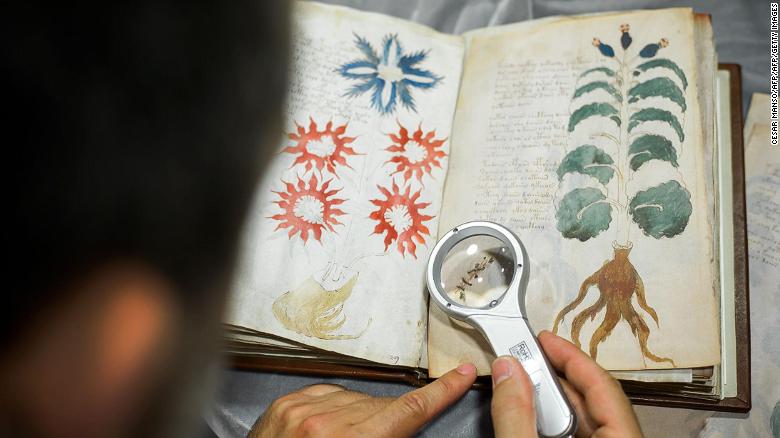Frayed, browned and in fragile condition, the Voynich manuscript currently resides deep in a basement at Yale University’s Beinecke Rare Book & Manuscript Library but digitized copies of it are available for free online.

Examining images from the manuscript.

Examining images from the manuscript.
Since it came to light over 100 years ago, many have tried and failed to decode the text — from US Army cryptographers to ordinary citizens postulating theories in the deepest corners of Reddit.
Its author and original title are unknown, and it is named for the collector and bookseller Wilfrid Voynich, who purchased it in 1912.
Ever since Voynich showed it off to the world, the incomprehensible text and cryptic illustrations have spurred countless theories about its meaning, origin, and the identity of its author. Some thought it might have been written by Leonardo Da Vinci or maybe even an autistic monk, others felt it might simply be an elaborate prank.
So what do we really know about the Voynich manuscript? Why has it captivated the imagination of so many through the decades? And will its mysteries ever be solved?
Lisa Fagin Davis, executive director of the Medieval Academy of America and a longtime Voynich scholar, says the first recorded appearance of the manuscript was when it was bought in the late 16th century by Holy Roman Emperor Rudolph II, who believed it had been written by 13th century British philosopher and alchemist Roger Bacon.

Some of illustrations in the book resemble known plants, others less so.
It then apparently traveled around Europe, disappearing for 250 years, before eventually being acquired by Voynich. Although Voynich never revealed where he got the manuscript, Davis says that his wife disclosed after his death that he had bought it from Jesuits outside of Rome.
In 2011, carbon-dating revealed the parchment dates back to the early 15th century, somewhere between 1404 to 1438. Analysis of the ink confirmed it was consistent with what was used during that period.
That dating rules out some of the names postulated as being the author, like Bacon, Da Vinci and Voynich himself. But beyond those facts, the manuscript offers more questions than answers.
It’s that sense of mystery that has captured the public imagination, and compelled so many to attempt to decipher its meaning.
Davis concludes “It’s magical. It really is. There’s nothing like it.”









